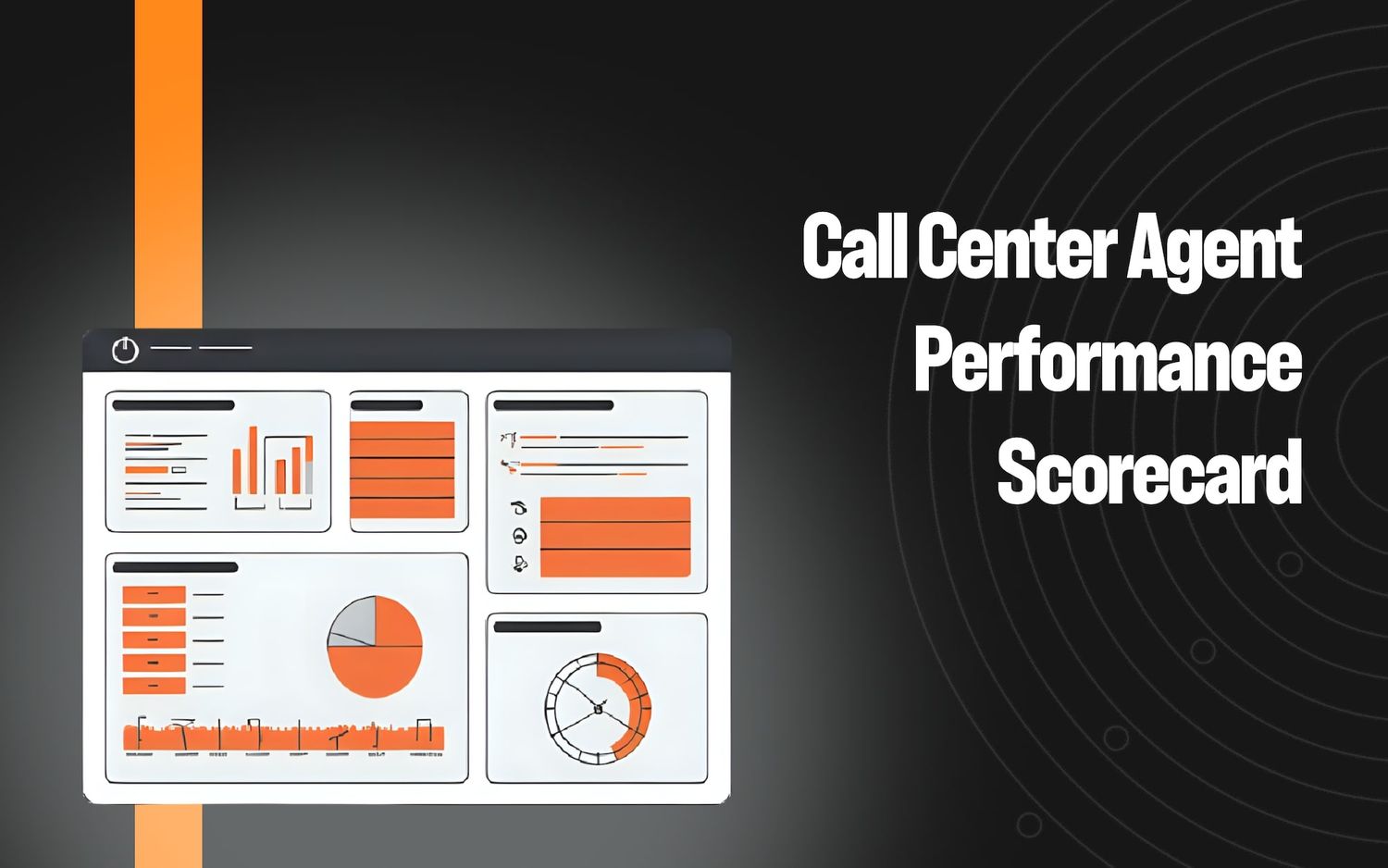8 Best Call Center Voice & Speech Recognition Software


Call center voice recognition has become a staple of modern call centers as it lets companies transcribe interactions to keep a record of what was said.
This has many potential uses. At a basic level, call transcripts let agents and managers review previous interactions and resolve disputes with customers.
But more advanced uses of speech and voice recognition in call centers are emerging. Namely, businesses can use speech analytics to parse and analyze these transcripts to identify customer pain points, track emerging trends, and offer agents recommendations for better performance.
These uses transform voice recognition software from a record-keeping tool into a powerful asset that dramatically improves call center performance and helps brands better understand their customers.
Below, we present a list of eight prominent options for automated speech recognition software, divided into two categories based on business needs:
- Specialized call center solutions offering speech recognition, along with built-in analyses and features tailored to call centers.
- General-purpose speech-to-text transcription tools, ideal for situations where all you need is a record of what was said, by whom, and when.
We’ll begin with sophisticated call center solutions, which offer the most value to companies that rely heavily on voice recognition technology for customer service.
First, we’ll explain how Level AI, our customer experience platform, uses voice recognition to provide businesses with deep insights into customer interactions.
General-Purpose Speech-to-Text vs Specialized Solutions: What’s the Difference?
Basic Transcription: A Simple Record of Conversations
General-purpose speech-to-text software excels at converting spoken conversations into written text, which is useful for:
- Keeping an official record of customer interactions for compliance and legal protection
- Allowing managers to manually review calls for quality assurance and coaching
- Providing a reference point for agent performance evaluations
However, transcription alone has limitations. Without analysis, no insights are gathered, and reading through transcripts is extremely time-consuming. As a result, most transcripts remain untouched unless there’s a specific need to refer to them.
Specialized Solutions: Beyond Transcription
In contrast, advanced call center platforms like Level AI combine voice recognition with natural language understanding to automatically analyze transcripts, unlocking deep insights into customer and agent performance.
Specifically, these tools help you:
- Flag key scenarios important to your business, from refund requests to customer praise.
- Provide live monitoring of conversations through a dashboard showing real-time KPIs to describe what’s actually happening during a call.
- Reveal voice of the customer and general patterns of what they’re perceiving and feeling about a brand, such as sentiment and customer satisfaction.
- Evaluate agent performance based on your company’s rubrics.
Artificial intelligence enables call centers to analyze every call transcript, turning transcription and voice recognition from a backup tool into a powerful resource for uncovering deep insights into what customers are saying, feeling, and thinking.
Below, we explore real-world examples from two categories of voice recognition software:
8 Options for Call Center Voice Recognition
Specialized Call Center Solutions
The following software goes far beyond basic transcription to provide features for AI use cases in the contact center, like improving service quality, agent performance, compliance, and operational efficiency.
1. Level AI: AI-Powered Speech Analytics to Improve Agent Performance and Better Understand Your Customers
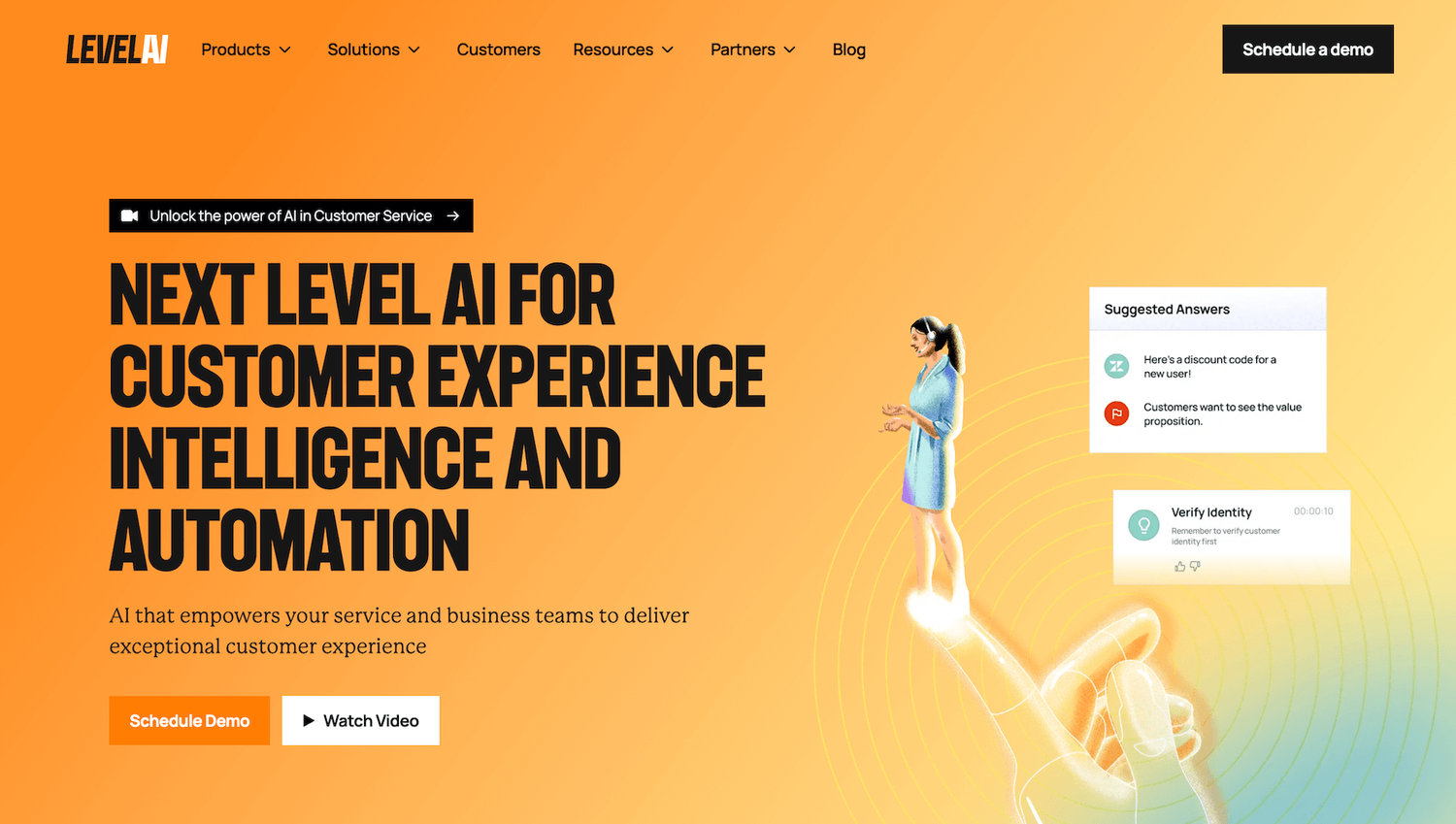
Level AI uses voice recognition to automate quantitative aspects of quality assurance, agent coaching, and customer sentiment analysis, so you can focus on the most impactful interactions, ensuring targeted coaching and more effective QA without the inefficiencies of random sampling.
We dive into how Level AI detects meanings and intents in natural language (based on conversations between agents and customers), and what the software enables contact centers to accomplish.
Detecting Customer Intent Expressed in Conversations
One of the foundational use cases of understanding customer interactions is flagging certain situations, phrases, or scenarios that are important to the brand.
Traditionally, platforms that don’t have AI powered natural language understanding would rely on preset rules such as keyword-matching to identify instances of customer intent (for example, flagging every time “refund” was mentioned). But this has significant flaws.
For instance, a system that’s pretrained to look for keywords relating to product refunds might easily flag conversations where a customer says, “I need a refund for this,” or “I don’t want a refund,” yet fail to correctly identify the intent of a statement using completely different terms like, “Can I get my money back.”
To account for variations in phrasing, administrators often need to enter dozens or even hundreds of keyword combinations or partial matches to capture a single intent (e.g., “Can I exchange this,” “Can I return this for full credit,” etc.). This is tedious.
Even if all potential refund-related phrases are manually entered, a rule-based system still won’t necessarily grasp the reasoning or context behind a customer’s request.
Is the customer seeking a refund because their package arrived damaged? Did they receive the wrong item? Or are they requesting a return due to a delay in shipping that made the item arrive too late to be useful?
In contrast, Level AI grasps the greater context in which words are being spoken to determine the true intent behind the request — regardless of specific wording.
It recognizes whether the customer is frustrated about a defective product, confused about the return policy, or simply inquiring about their options. This deeper understanding lets businesses respond effectively, and is the basis for advanced features that improve customer satisfaction and service operations.
Our platform’s Scenario Engine recognizes and classifies intent expressed in conversations between agents and customers as scenarios. For example, if an agent isn't authorized to resolve a particular issue and must pass the customer to a specialized department, the system recognizes this as an “Escalation”:
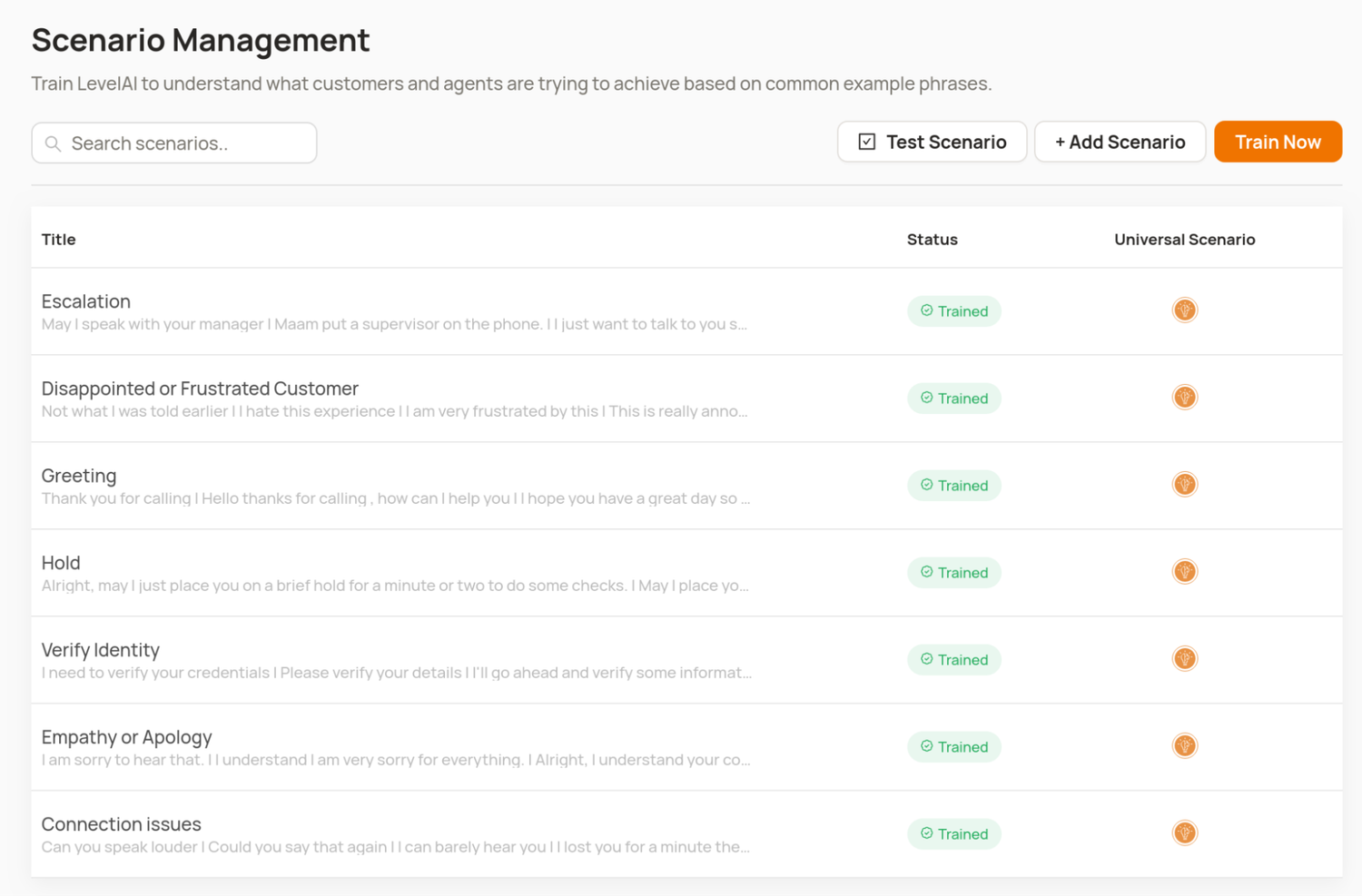
The system comes with a number of predefined scenarios out of the box, but you can define your own according to your specific business by providing example phrases of how customers would express a particular intent:
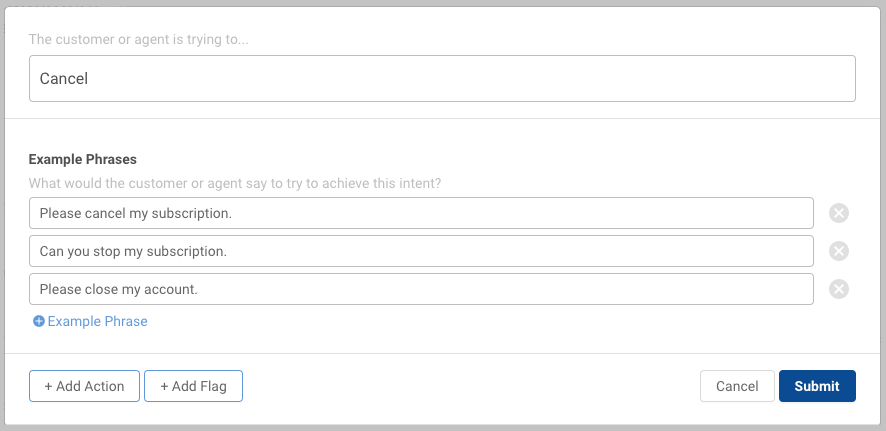
The platform isn’t simply scanning for those phrases, but rather it uses them as a basis to understand the wider context around the scenario. It indicates the occurrence of these in conversation transcripts using conversation tags, each representing a distinct scenario. Each tag highlights the place in a conversation where a customer or agent expressed a particular intent.
Conversation tags are also searchable, allowing you to display conversations where a particular intent was expressed. For example, searching on a tag labeled “Agent Follow-Up,” would show all conversations where an agent mentioned they would follow up on an issue.
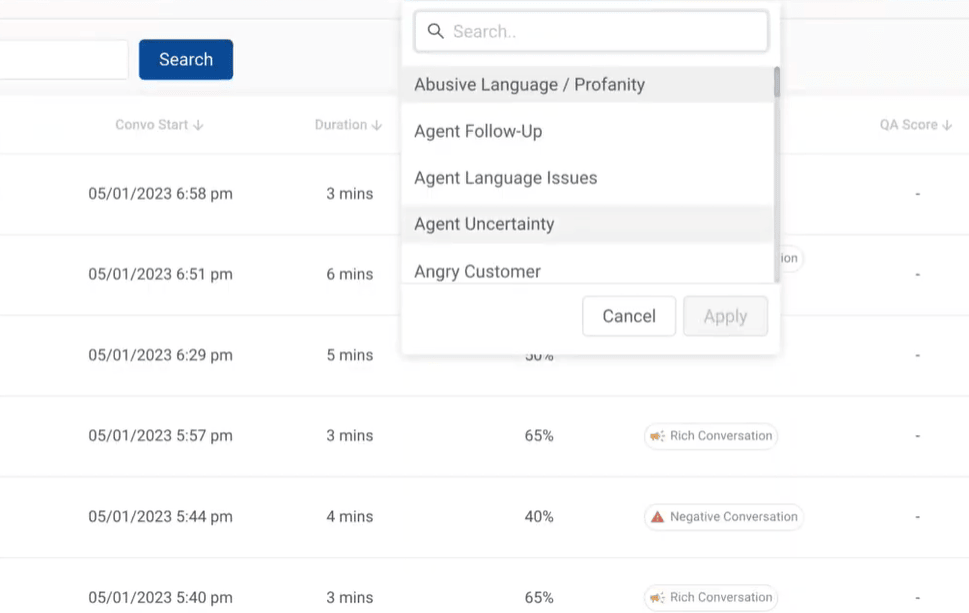
Conversation tags are fully reportable against other variables within Level AI’s Reporting and Analytics feature, allowing you to report on, say, a particular product issue versus average resolution rate.
Identifying and Classifying Customer Emotions
While the above helps flag certain scenarios like whenever a customer requests a refund or wants to cancel, it's also useful for brands to keep tabs on overall customer sentiment such as happiness and disappointment, so they can proactively address concerns and reduce churn.
While most comparable CX platforms identify only direction (positive or negative) and intensity of sentiment, Level AI detects actual emotions. What's more, our platform detects more emotions than any other software in its category:
- Happiness
- Disappointment
- Frustration
- Gratitude
- Admiration
- Anger
- Annoyance
- Worry
The system indicates detected emotions using sentiment tags. As with conversation tags, you can search for particular emotions in order to display all conversations in which that emotion was expressed.
Sentiment tags are also reportable against other dimensions in Level AI’s Reporting and Analytics feature.
Level AI scores the overall emotional intensity of a customer’s experience during a single interaction using a Sentiment Score, which is calculated from all detected emotions and gives it a single value between zero and 10, with zero being the most strongly negative, and 10 being the most strongly positive.
Each detected sentiment is weighted differently depending on where it occurs in the conversation. For example, sentiments detected towards the end of a conversation are weighted more heavily than those occurring earlier, as emotions experienced after an issue’s resolution (or non-resolution) are usually more indicative of a customer's lasting feelings towards your brand.

Analyzing Recurring Themes in Customer Interactions
A major benefit of analyzing data from customer interactions such as call transcripts is that it gives you a broader understanding of customer needs, pain points, and expectations than more traditional means, such as post-interaction surveys.
This is especially true when it comes to collecting voice of the customer (VoC) data. Surveys are a useful way to ask the questions you want to ask but not everyone will respond, and those who do typically comprise the extremes of opinion (either the very satisfied or very dissatisfied) rather than the “middle majority.”
Read more: 8 Top SurveyMonkey Alternatives
Survey results can therefore sometimes be skewed in the direction of one extreme or another.
Level AI’s VoC Insights derives standard metrics like CSAT, NPS, CES, etc., from customer interaction data rather than from surveys, capturing unfiltered feedback from 100% of customer interactions rather than relying on a smaller subset of respondents who choose to fill out a survey.
Although surveys allow you to ask questions in a structured way, using customer satisfaction software like Level AI to analyze unstructured customer interactions nonetheless has certain advantages:
- Interaction data is highly representative of customer satisfaction, as it includes feedback from all interactions across all channels (e.g., calls, emails, chats, etc.), rather than relying on a small, self-selected group of survey respondents.
- Live customer interactions convey emotions, pain points, and intents expressed in the moment, making the feedback accurate and actionable.
Beyond standard CSAT metrics, our VoC Insights also detects more subtle trends in customer interaction patterns that may otherwise go unnoticed.
These insights help businesses uncover hidden frustrations, emerging trends, and behavioral patterns that traditional surveys or basic analytics might miss.
Such patterns are typically found in everyday customer interactions, and include tonal shifts, hesitations, repeated questions, or indirect dissatisfaction expressed in calls and messaging.
For example, a number of customers might matter-of-factly express delays in receiving their orders, which may nonetheless signal a growing issue with delivery times, and potentially result in future churn.
This is a trend that VoC Insights would detect and display in the platform's intuitive dashboards:
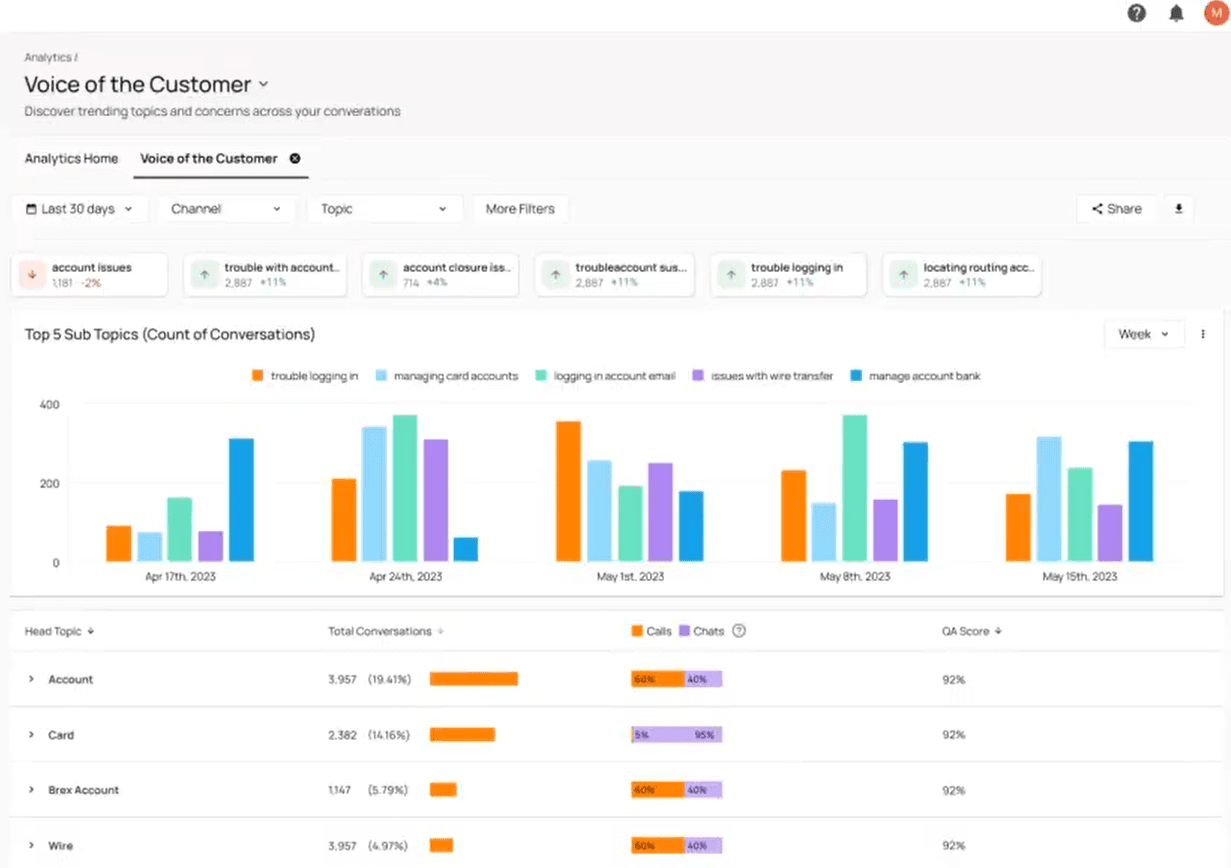
Using Level AI��’s VoC Insights, one leading financial institution was able to identify cancellations as a major source of calls that could be deflected by adding a cancellation option in their IVR system and thus saving over $3 million in a year.
Level AI also offers iCSAT, or inferred customer satisfaction score, which is a more holistic measure of satisfaction than CSAT as it’s based on all interactions of a customer and takes into account:
- Resolution score: for understanding whether or not a customer’s issue was eventually resolved (either fully or partially).
- Sentiment Score: for detecting a customer’s overall sentiment during conversations.
- Customer effort score: for understanding how hard it was for the customer to resolve their issue, such as whether they had to navigate a complex phone menu, re-enter their account details multiple times, or search extensively for self-service solutions before reaching an agent.
This gives you a more comprehensive and accurate view of customer satisfaction:
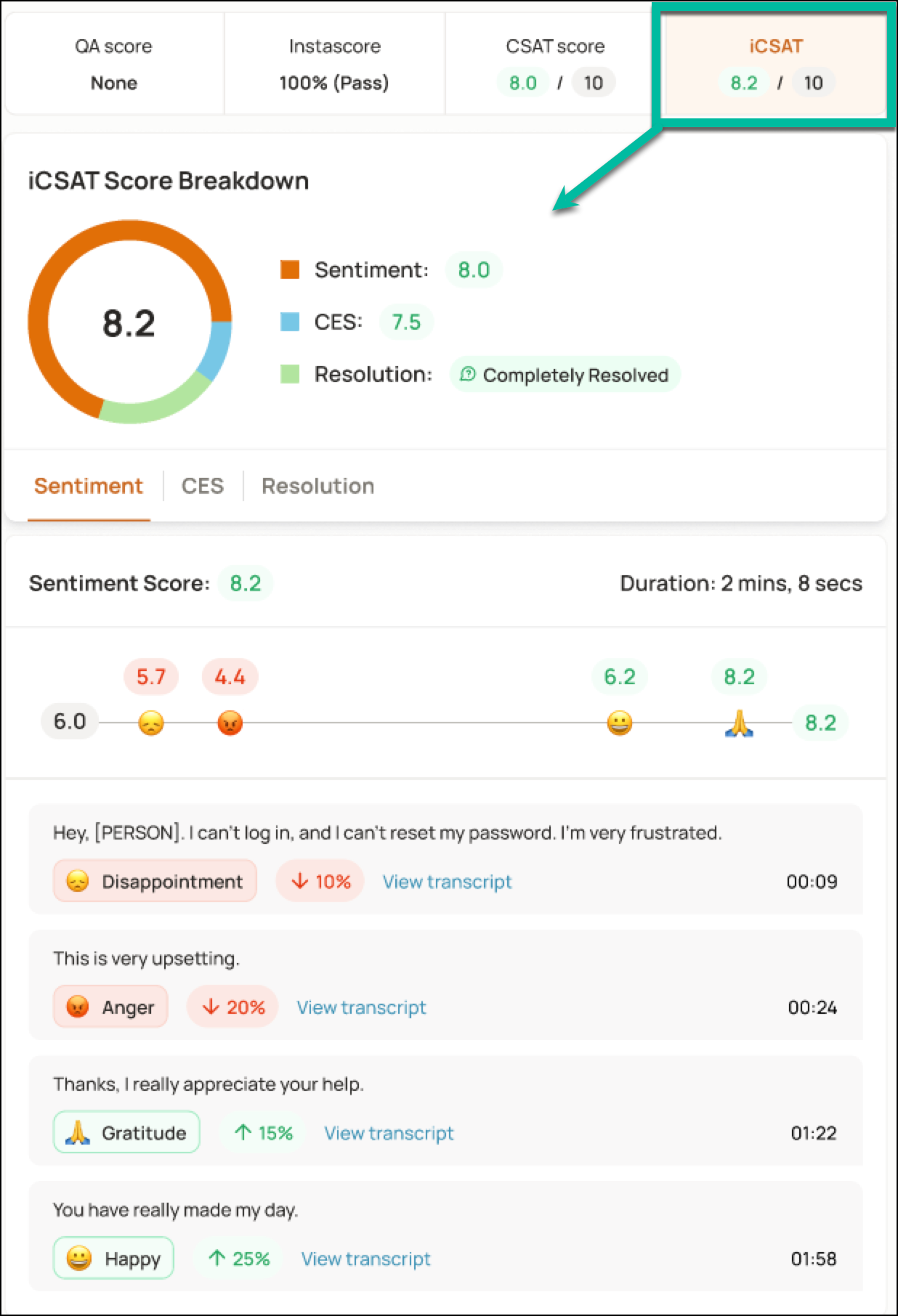
Auto-Scoring Agent Performance
The platform auto-scores agent performance to provide a single percentage value for each interaction, called InstaScore.
InstaScore is a quantitative measurement of how well an agent adheres to predefined rubrics such as:
- Did the agent greet the customer professionally and set the right tone for the conversation?
- Did the agent explain solutions clearly and avoid using jargon or overly technical terms?
- Did the agent follow security and verification protocols correctly?
- Did the agent maintain a positive and professional tone throughout the call?
Agent InstaScore is shown next to each conversation in our dashboard:
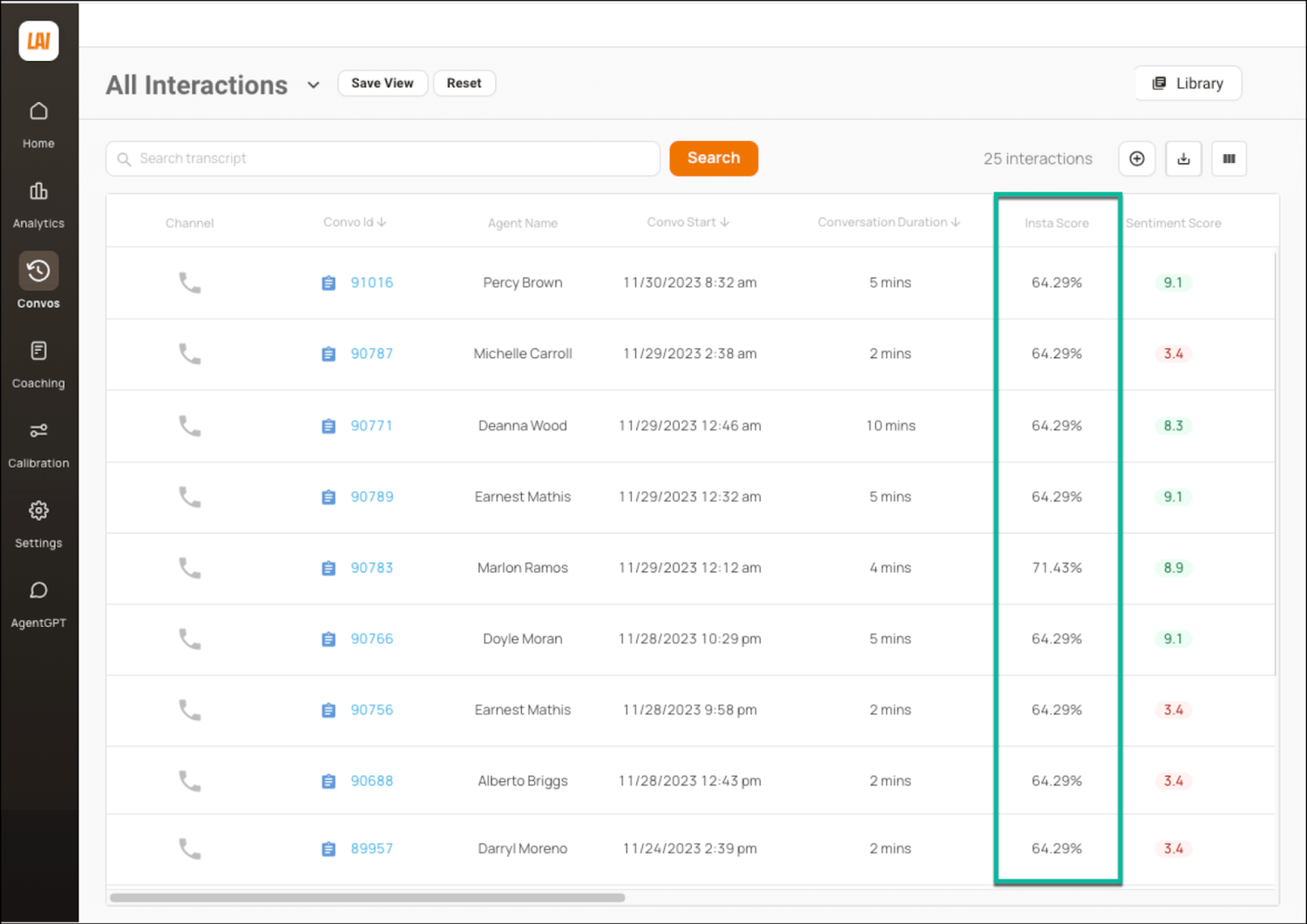
This provides unbiased scoring for all conversations and allows you to efficiently sample interactions featuring high- and low-performing agents to better implement best practices for call center quality assurance.
Real-Time Assistance for Agents and Managers
Outside of analyzing recorded conversations, Level AI’s real-time detection of intent and sentiment also lets us provide instant answers for agents and live monitoring capabilities for managers.
Real-Time Agent Assist displays useful and relevant information to agents while on support calls, reducing wait times and equipping agents to handle complex queries on the spot.
It uses NLU and conversational AI to understand what’s being discussed and displays the appropriate knowledge base topics in the moment an agent needs them, rather than having to put customers on hold while they search for information.
Real-Time Agent Assist displays a unified feed showing real-time guidance and suggested responses, including agent scripts, FAQ items, warnings, knowledge base articles, and more, depending on what’s currently under discussion.
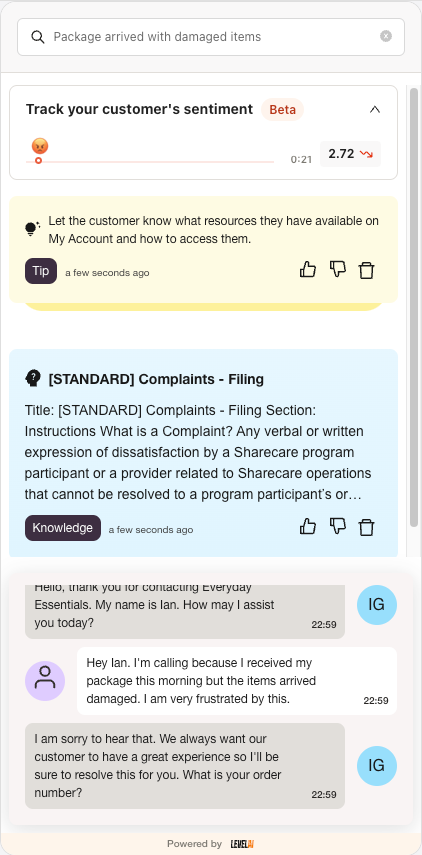
The search bar of Agent Assist auto-populates with suggested search topics to speed up searching, and displays a chat-like user interface called AgentGPT, which is like an autonomous agent in your browser and allows service representatives to actively query their knowledge base.
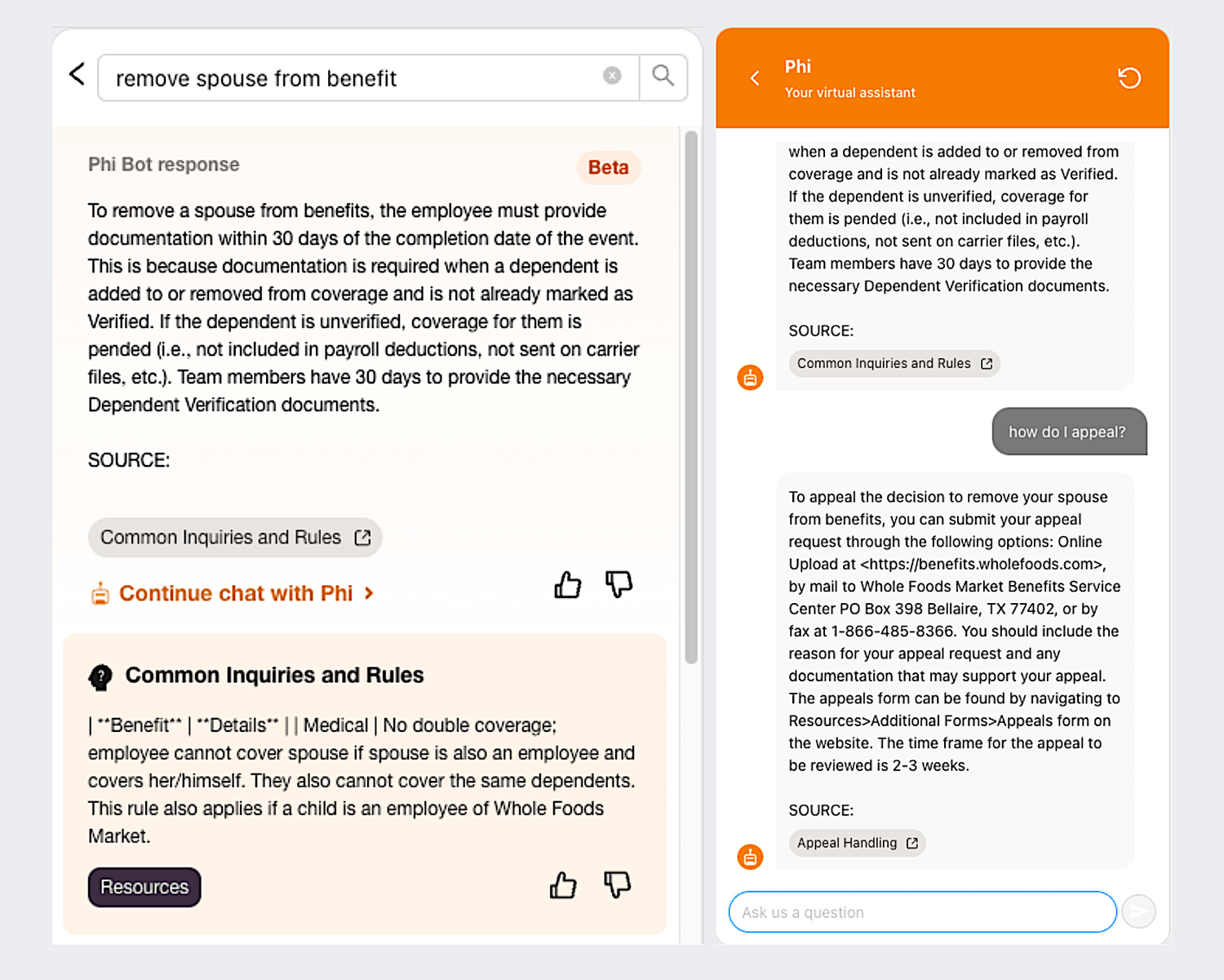
Real Time Agent Assist is designed to give answers to agents faster and to minimize wait times, as well as to reduce agent stress.
Catering management platform ezCater uses Real Time Agent Assist in its customer service and has experienced a 13% decrease in overall call handling time.
Supervisors monitoring calls in a contact center traditionally refer to simple metrics like call duration, randomly sample calls to listen in on, or wait for agents to request help as factors for deciding whether to scrutinize a call more closely.
This is, however, a reactive rather than proactive way of identifying calls needing their attention.
Real-Time Manager Assist uses real-time speech analytics to give supervisors a high level of situational awareness about ongoing, live conversations, enabling them to maintain service quality, proactively address challenges, and foster a culture of continuous improvement.
Its call monitoring software displays all calls in a contact center, along with several key pieces of information that allow managers to instantly gauge how conversations are going, including:
- Call duration
- Estimated deal size and conversion probability
- Ongoing Sentiment Score, InstaScore, and any related flags indicating positive or negative characteristics of the call (i.e., Coachable Insights)
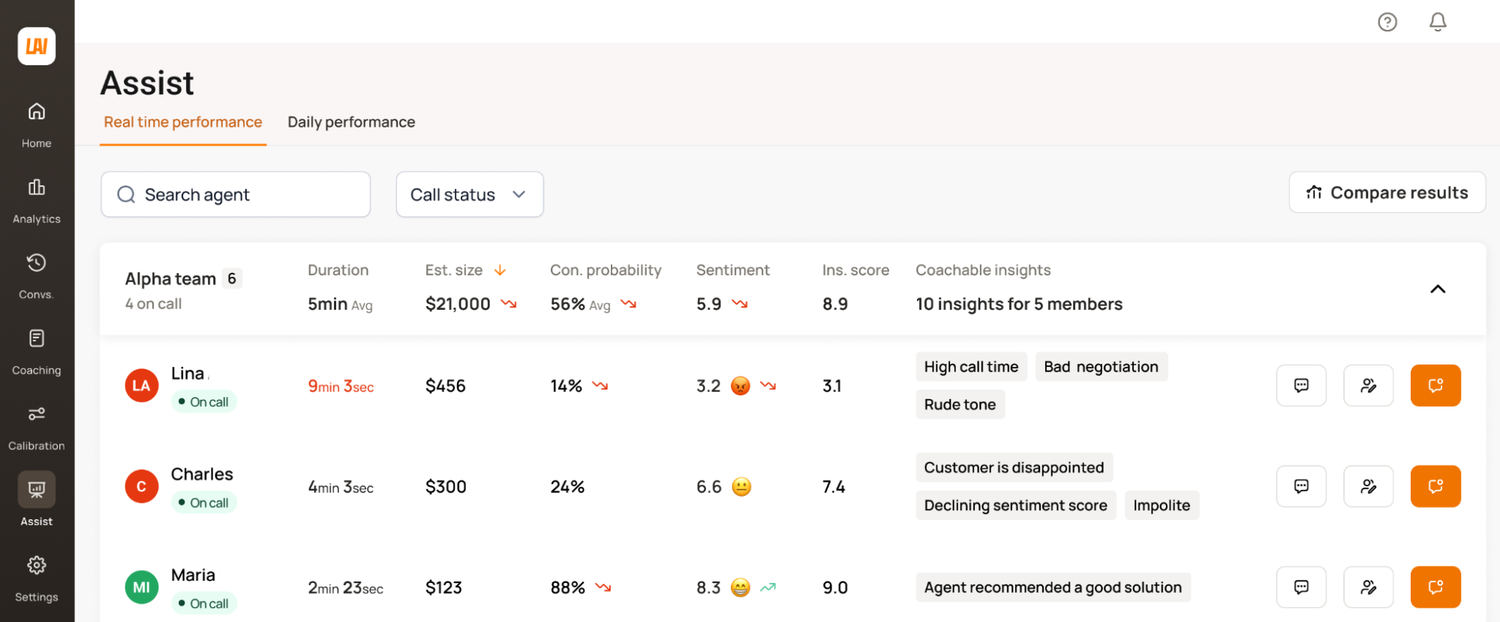
Managers can click into any of these stats to show further details or evidence of the values displayed, or even start a coaching session.
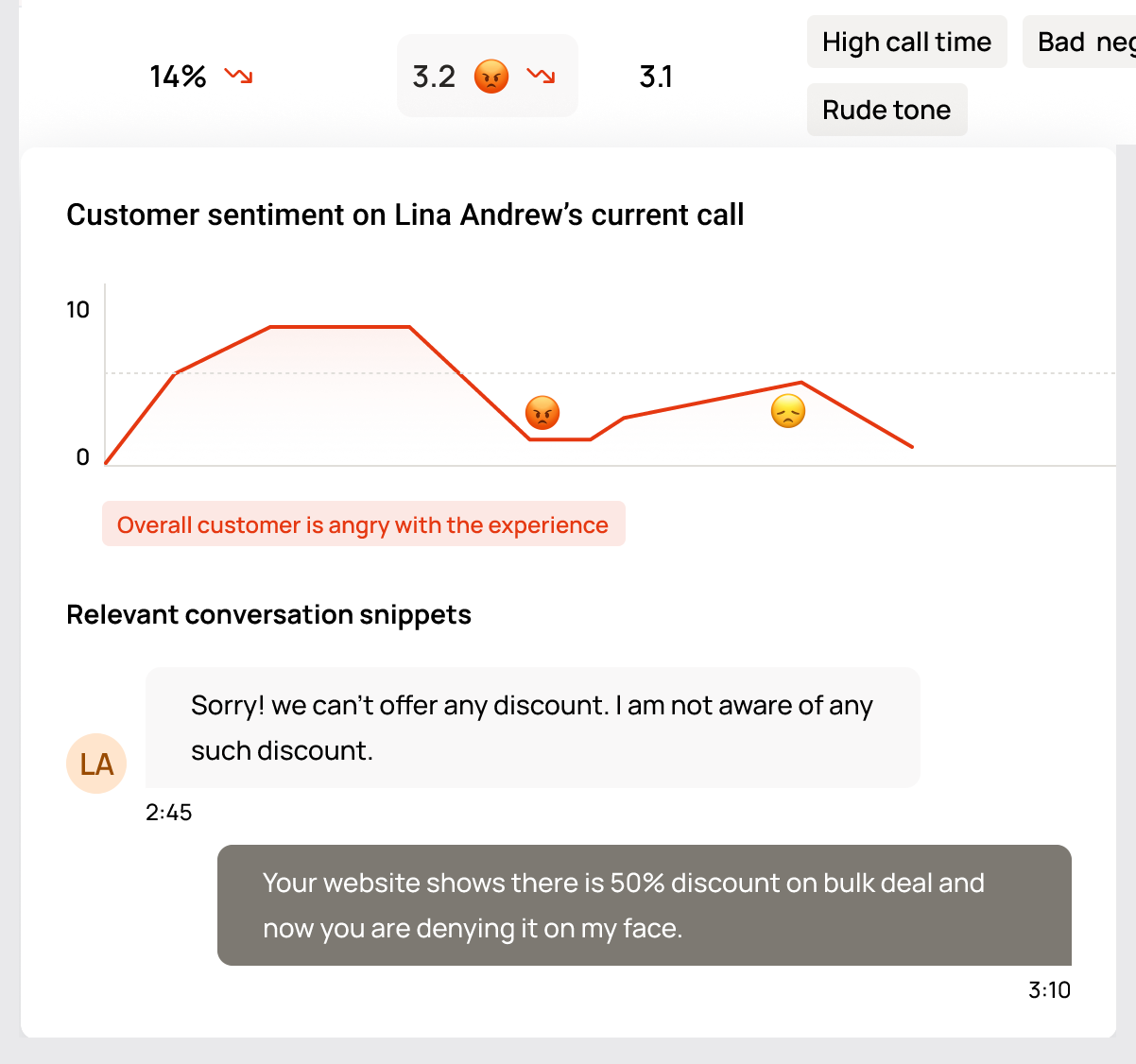
Managers can also intervene as needed using call whispering or call barging.
For those too busy to constantly monitor a screen, the system can be configured to send out alerts on Slack, Microsoft Teams in case a preconfigured trigger is reached, like a customer churning.
One Source of Truth: Unified Reporting Across Silos
Data in contact centers is often fragmented across multiple tools, systems, and departments, creating significant challenges in achieving a unified view of customer interactions.
For example, calls are recorded in one platform, chats and emails are stored in another, while CRM systems contain customer history and case details.
Because the systems don't always share data with each other, insights into why a customer is frustrated or which agents need coaching on certain topics become difficult to track and report on holistically.
Level AI’s Query Builder lets you pull in and query data both from within our platform and from external sources, like from your ticketing system, CRM, or survey software.
You can include Level AI data like sentiment tags, InstaScore, VoC data, and more in your call center analytics dashboard.
This lets you combine different data types and reporting dimensions in a variety of ways to ask questions like:
- Which conversation topics or intents are most commonly associated with negative sentiment?
- Are there specific phrases or agent behaviors that correlate with higher customer satisfaction?
- What are the most common unresolved issues that lead to repeat customer contacts?
- Are there particular product or service complaints that are increasing over time?
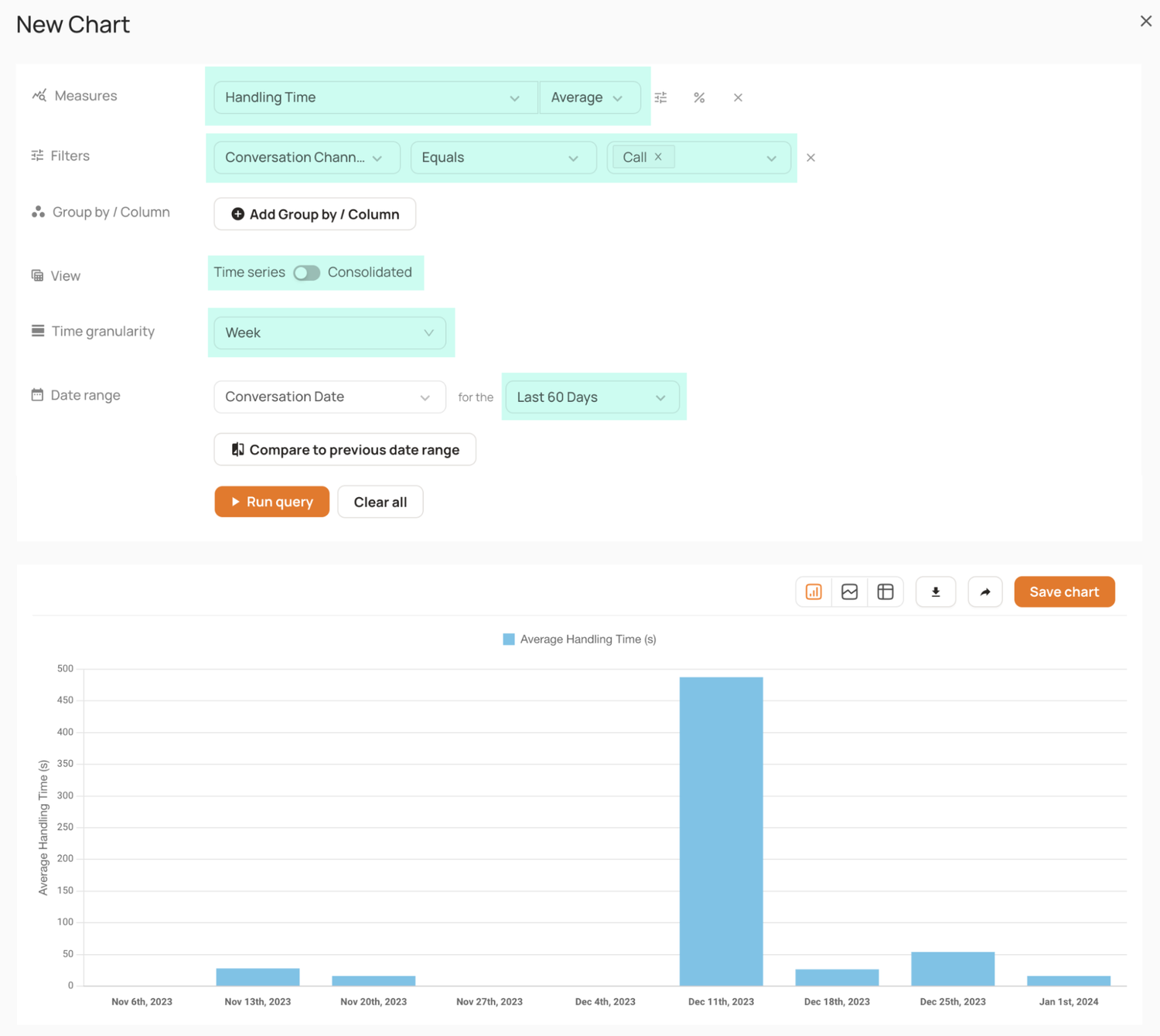
Scale QA with Automated Voice Recognition
Level AI’s secure and customizable Generative AI automates QA with AI speech analytics, allowing you to review 100% of customer interactions instead of just a small sample. By analyzing calls in real-time, your team can focus on strategic improvements rather than manual audits.
Schedule a call with Level AI today and learn how automated QA can boost your customer experience.
2. NICE: Omnichannel Capabilities on a Cloud-Native Platform
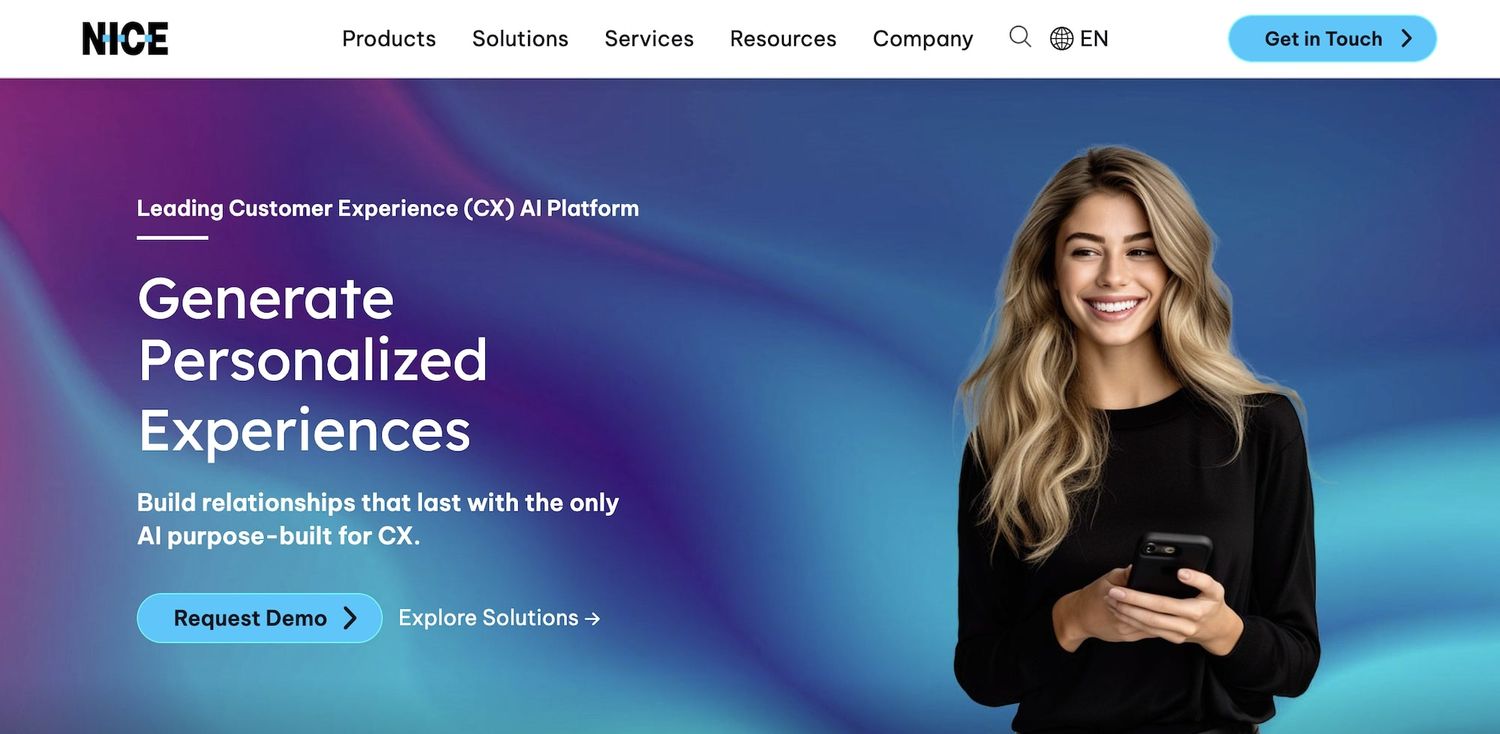
NICE CXone is a cloud-native customer experience platform that uses advanced voice recognition and offers a unified solution for managing customer interactions across multiple channels.
It offers a variety of AI speech analytics features for call routing, workforce optimization, and assisting agents.
- CXone uses AI-driven voice recognition across multiple channels, including voice calls, to provide seamless customer experiences.
- It integrates ASR into its Interactive Voice Response (IVR) system, allowing callers to respond to prompts by speaking rather than using touch-tone inputs. This feature uses the industry-leading Nuance ASR engine to enhance voice recognition accuracy.
- It uses voice biometrics for passive and dynamic conversational authentication, improving security and streamlining the customer verification process.
Base pricing is around $70 per user per month and depends on which modules you want to use. You can also get the entire suite of CXone products for around $250 per month.
3. Verint: Analyzes Voice Interactions as They Happen
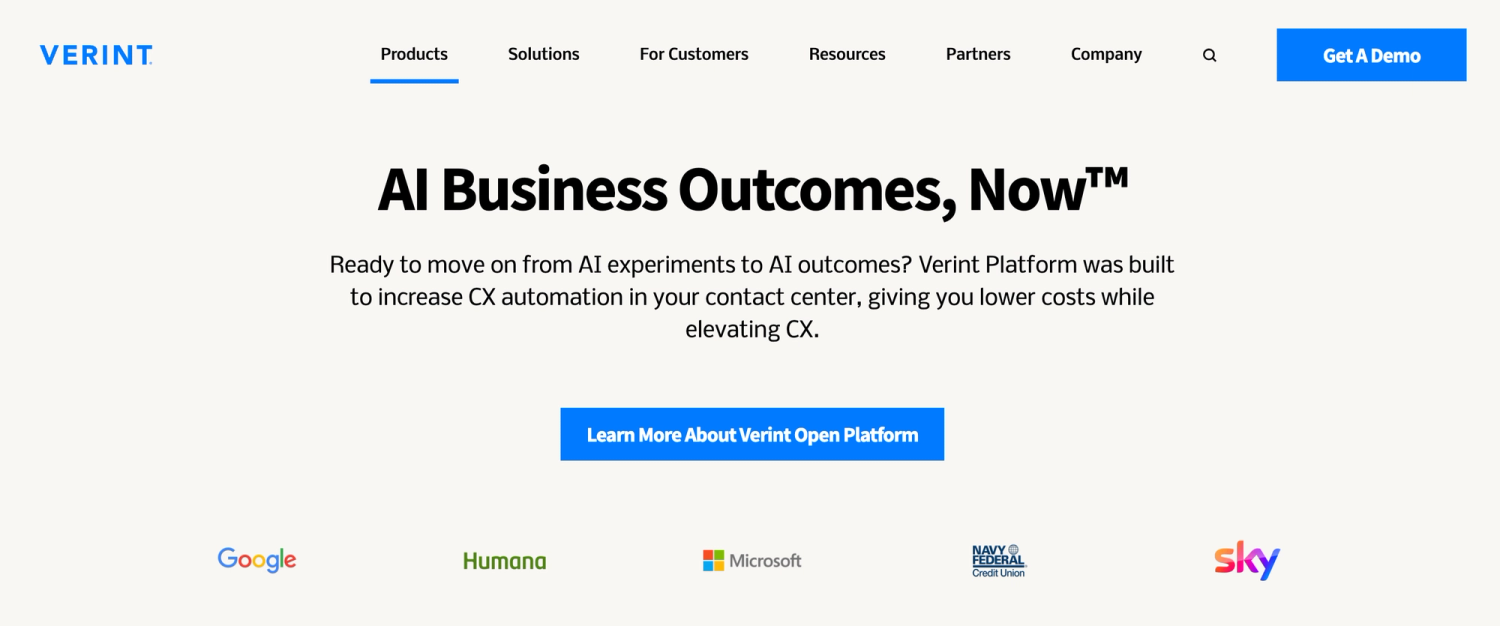
Verint is an advanced software solution that streamlines customer experience (CX) and improves contact center performance. It automatically analyzes recorded customer calls to extract valuable insights and intelligence, helping businesses improve customer satisfaction and workflows.
- The software uses Verint Da Vinci Transcription Engine, a speech-to-text solution that transcribes contact center conversations.
- Verint Speech Analytics uses semantic intelligence to determine connections between spoken terms and phrases, identifying relationships and significance.
- Verint Real-Time Speech Analytics can "listen" to voice interactions as they happen, applying rules to detect sentiments and user-defined words or phrases of interest during live calls.
- The system allows for customization to improve accuracy further, including adding new terms, correcting pronunciations, and adapting to specific contact center environments.
You must contact Verint’s sales team for a price quote.
4. Genesys: Delivers Personalized Customer Experiences
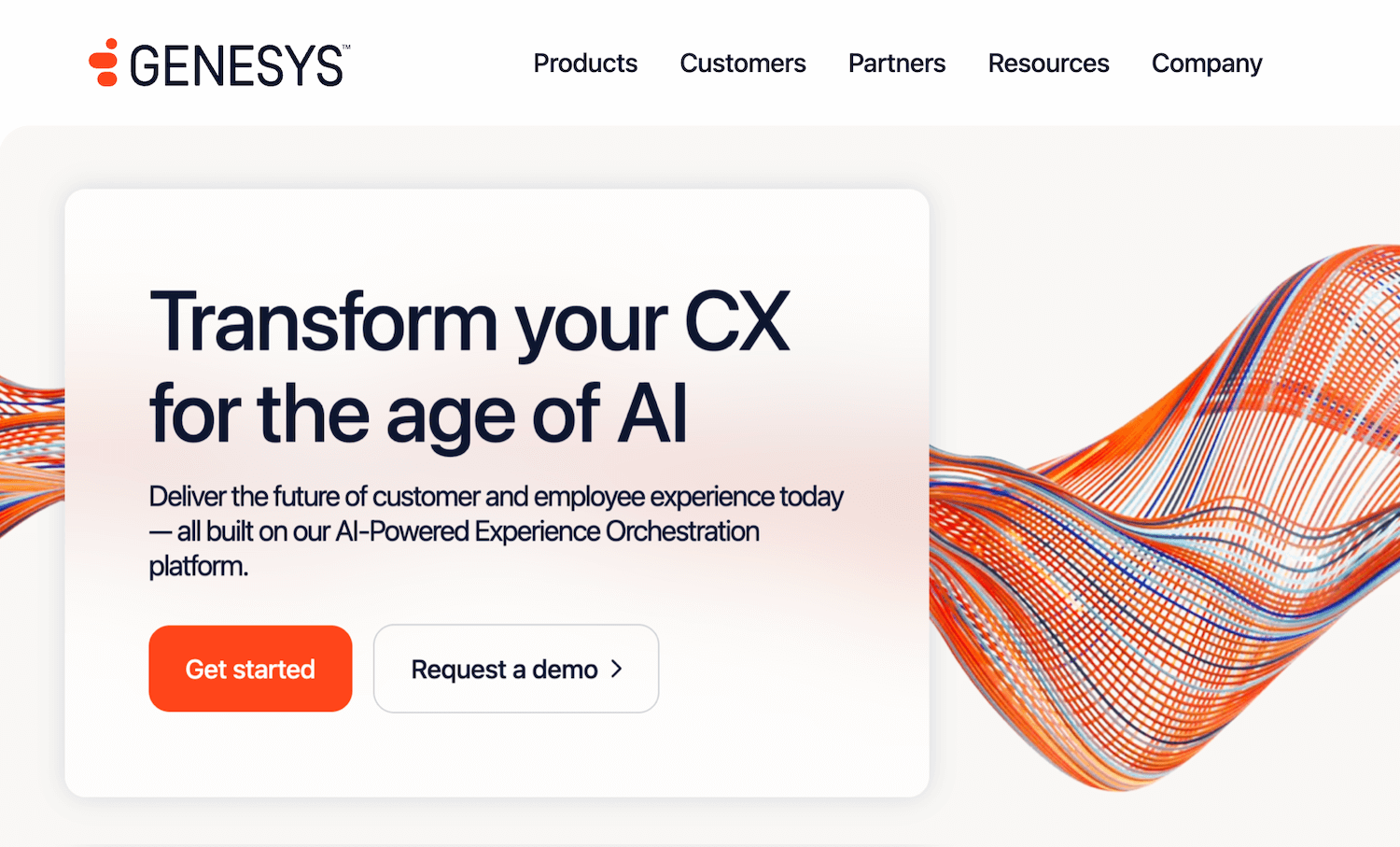
Genesys offers a platform called Genesys Cloud CX, which orchestrates experiences across customer and employee interactions. This AI-powered platform helps businesses improve customer support operations and gain valuable insights from customer interactions.
- Genesys uses native, embedded AI to power personalized experiences, mine customer insights, and optimize operations.
- It includes tools for workforce optimization, scheduling, performance management, and employee engagement.
- Its Interaction Analytics uses speech analytics to identify and categorize topics discussed between agents and customers.
- The platform supports open APIs, pre-built integrations, and the AppFoundry Marketplace for easy customization and expansion.
Pricing plans start around $75 per user per month for a voice contact center, scaling up to $250 per user per month for full AI capabilities.
General-Purpose Speech-to-Text Transcription Tools
These tools provide capabilities for automated speech recognition for contact centers.
5. Google Cloud Speech-to-Text: Recognizes a Wide Number of Languages & Dialects
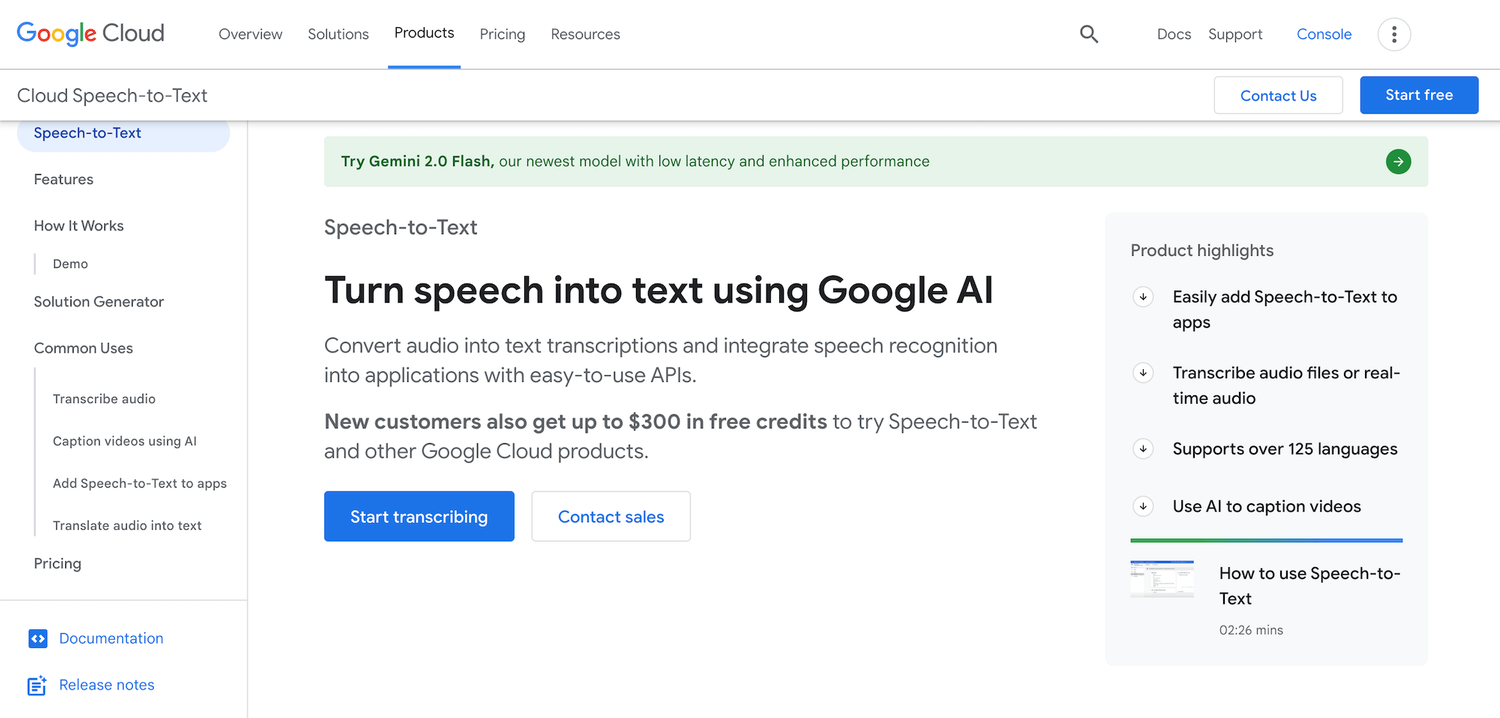
Google Cloud Speech-to-Text is a service that converts spoken language into written text using Google's machine learning technology. It offers automated speech-to-text conversion and transcription capabilities for over 125 languages and dialects.
The service utilizes Google's Chirp foundation model, which is trained on millions of hours of audio data and billions of text sentences, providing improved recognition and transcription across various languages and accents.
The software:
- Handles both real-time streaming audio and pre-recorded files.
- Manages noisy audio from various environments without requiring additional noise cancellation.
- Includes automatic punctuation in language transcriptions.
- Identifies and differentiates between different speakers in audio content.
Prices are highly variable and are based on API version, channels, batch methods, and any additional Google Cloud service costs like storage. Currently, Google’s Speech-to-Text V2 API costs around 2 cents per minute to use.
6. Amazon Transcribe: Seamless Integration with Other AWS Services
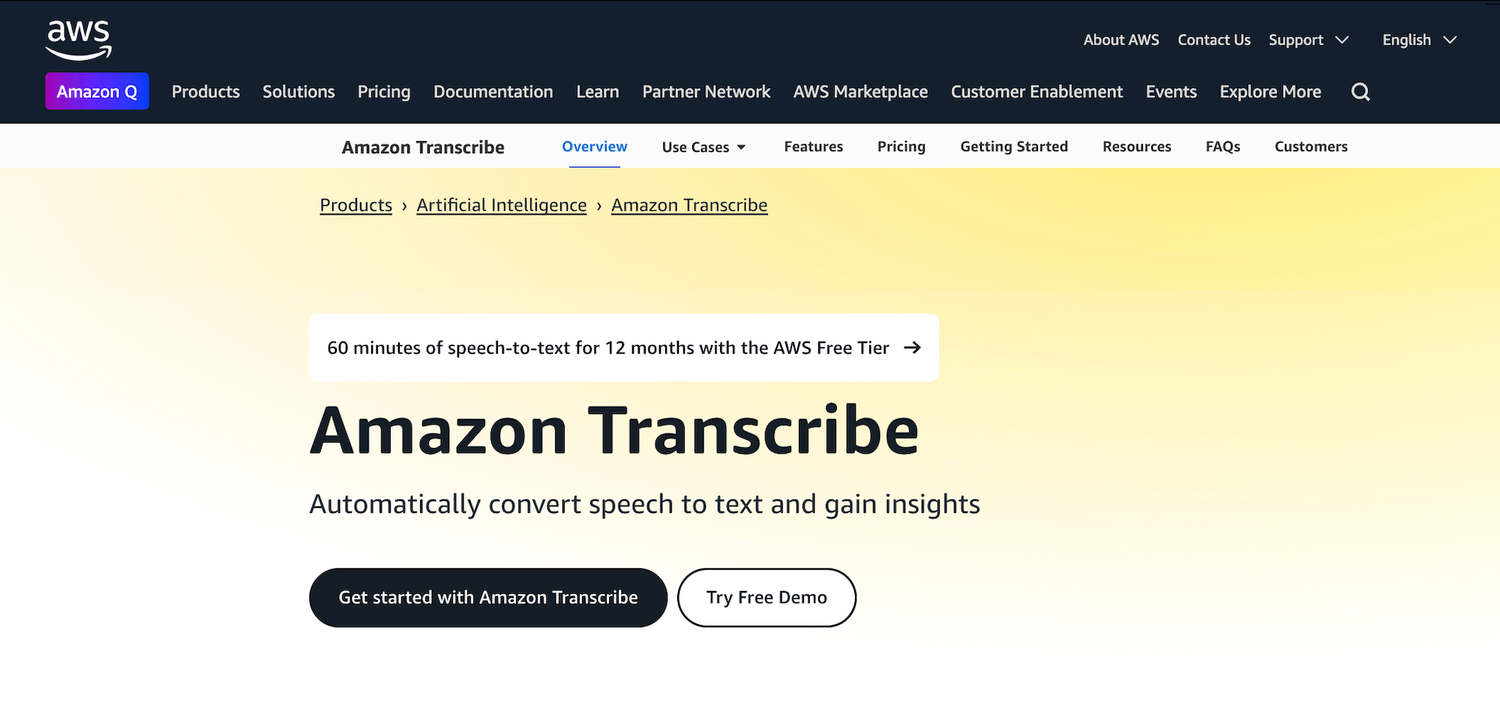
Amazon Transcribe is an automatic speech recognition service that uses machine learning technology to convert audio into text. It's part of AWS and is a fully managed automatic speech recognition service, which is based on a multi-billion parameter speech foundation model.
- Users can transcribe existing audio recordings or streamed audio.
- It supports automatic language identification, allowing it to transcribe audio files in different languages.
- Users can create custom language models to improve accuracy for domain-specific terminology.
- It identifies and attributes speech to multiple speakers in a single audio file.
Amazon Transcribe offers a free tier of 60 minutes per month for the first year. Besides API-based standard pricing, the service offers a number of add-ons.
7. IBM Watson Speech-to-Text: Create Custom Language Models for Domain-Specific Terminology
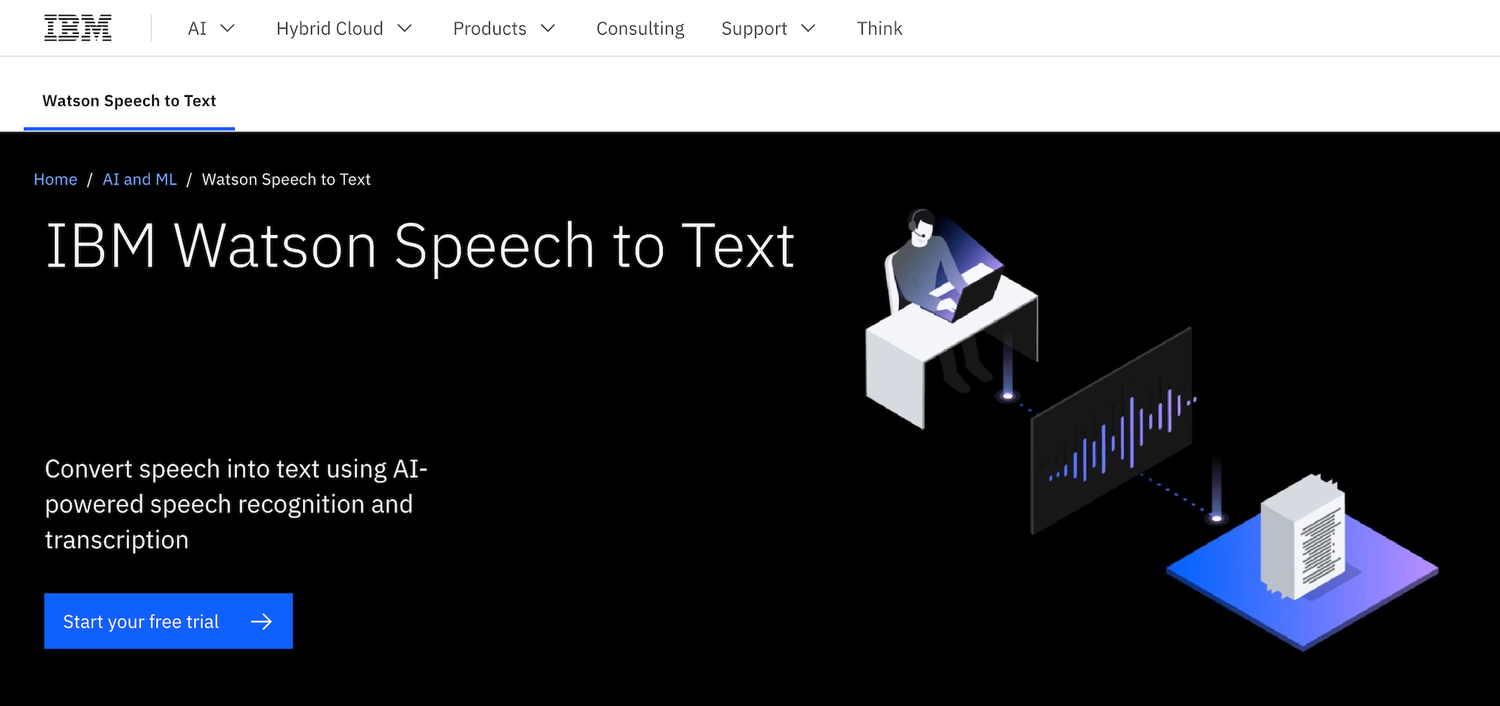
IBM Watson Speech-to-Text is an AI-powered service that converts spoken audio into written text. It uses neural technologies and machine learning algorithms to accurately transcribe speech from various sources, including live audio streams and pre-recorded files.
- The service supports multiple languages, including Arabic, English, Spanish, French, Brazilian Portuguese, Japanese, Korean, and Mandarin.
- It can transcribe speech in real-time as audio is playing, or process uploaded audio files in batch mode.
- Users can train the system on domain-specific terms and acoustic models to improve accuracy for specialized use cases.
- The service can identify and distinguish between multiple speakers in a conversation, supporting up to six speakers in an audio file.
The service offers a free tier with up to 500 minutes of speech recognition a month at no charge, with a choice of 38 pre-trained speech models.
Thereafter, its Plus tier starts at one cent a minute, and further tiers are available with undisclosed pricing.
8. Microsoft Azure Speech Service: Full Integration with Azure Ecosystem
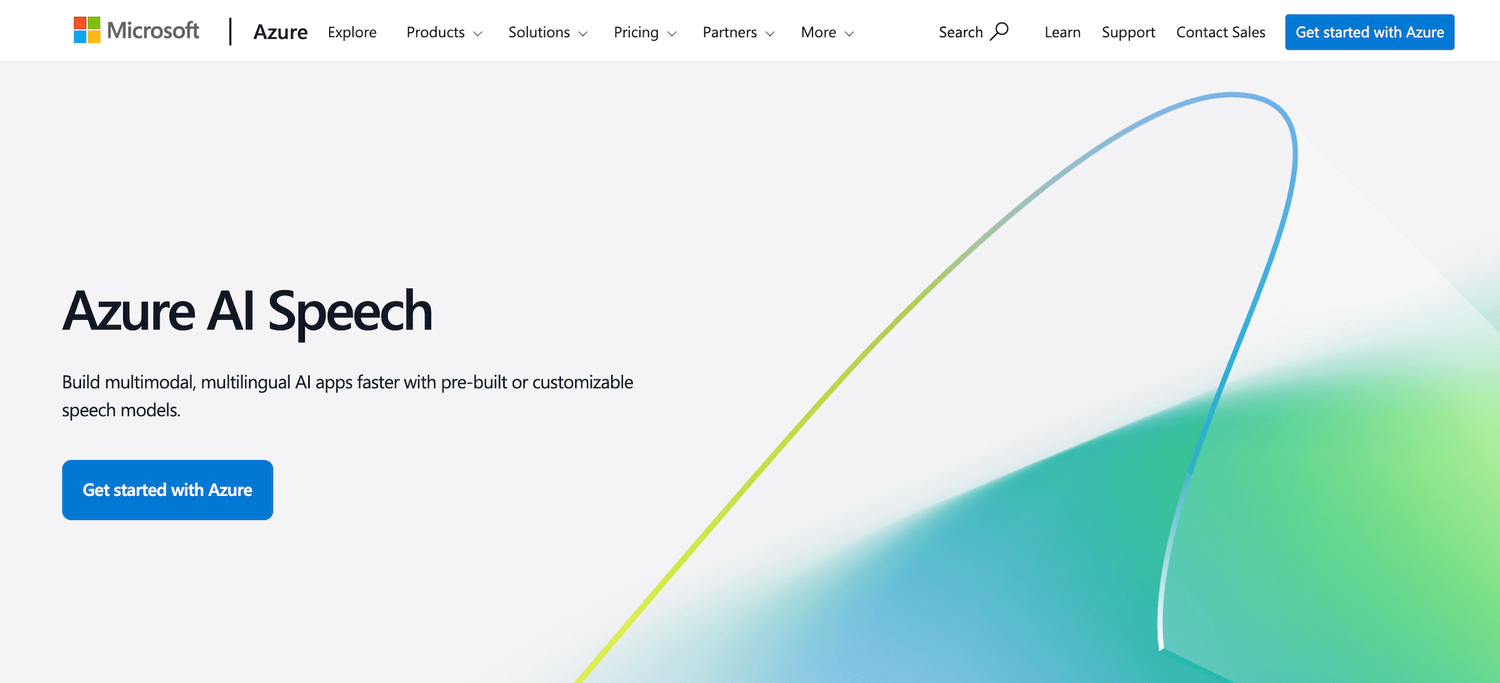
Microsoft Azure Speech Service is a part of Azure AI services that provides advanced speech-to-text and text-to-speech capabilities. It offers a range of automation features for converting audio into text and synthesizing human-like speech from text input.
- Accurate transcription of audio streams into text, supporting both real-time and batch processing.
- Conversion of text into natural-sounding synthesized speech, with options for prebuilt neural voices and custom voice creation.
- Multilingual speech-to-speech translation for 76 input languages, with latency improvements delivering results in less than five seconds.
- Ability to create custom speech models, add specific vocabulary, and build personalized voice models.
Azure’s free tier includes five hours per month at no charge. Otherwise it offers a pay-as-you-go pricing model.
Transform Your Contact Center with Smarter Voice AI
Level AI’s advanced voice recognition technology ensures that every customer interaction is captured, understood, and analyzed with near-human accuracy.
Our conversational intelligence software can empower your contact center to increase agent performance, improve customer experience, and gain deeper insights from every call.
Schedule a demo to discover the power of AI-driven speech analytics in action.
Keep reading
View all

